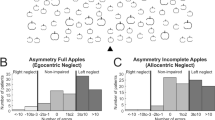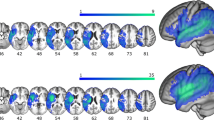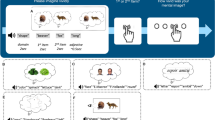Abstract
The current study aims to investigate visual scene perception and its neuro-anatomical correlates for stimuli presented in the central visual field of patients with homonymous hemianopia, and thereby to assess the effect of a right or a left occipital lesion on brain reorganization. Fourteen healthy participants, three left brain damaged (LBD) patients with right homonymous hemianopia and five right brain damaged (RBD) patients with left homonymous hemianopia performed a visual detection task (i.e. “Is there an image on the screen?”) and a categorization task (i.e. “Is it an image of a highway or a city?”) during a block-designed functional magnetic resonance imaging recording session. Cerebral activity analyses of the posterior areas—the occipital lobe in particular—highlighted bi-hemispheric activation during the detection task but more lateralized, left occipital lobe activation during the categorization task in healthy participants. Conversely, in patients, the same network of activity was observed in both tasks. However, LBD patients showed a predominant activation in their right hemisphere (occipital lobe and posterior temporal areas) whereas RBD patients showed a more bilateral activation (in the occipital lobes). Overall, our preliminary findings suggest a specific pattern of cerebral activation depending on the task instruction in healthy participants and cerebral reorganization of the posterior areas following brain injury in hemianopic patients which could depend upon the side of the occipital lesion.





Similar content being viewed by others
Notes
For behavioural data, in healthy controls a significant main spatial frequency effect (F2,26 = 9.61, p < 0.001) as well as a significant spatial frequency x task interaction were observed for ER (F2,26 = 4.31, p < 0.05) revealing a higher ER [6.1 % ± 3.2] when HSF-images were presented (compared to LSF [0.6 % ± 0.1] and UF [0.1 % ± 0.02]–images) in the detection task only (ER in the categorization task: HSF-images = 6.4 % ± 6.2, LSF-images = 5.3 % ± 6.7; UF-images = 5.6 % ± 4.6). For RTs there was a significant spatial frequency effect (F2,26 = 12.05, p < 0.001) highlighting the classic coarse-to-fine time course for spatial frequency processing (i.e., longer RT for HSF than for LSF or UF–images; e.g., Cavézian et al. 2010). However, in each patient, the type of images did not influence ER or RTs. For imaging data, we investigated the specific role of spatial frequency in each task by extracting parameter estimates from the clusters activated within the occipito-temporal and parietal cortices in the detection task (left inferior occipital gyrus, right inferior occipital gyrus, and left superior parietal lobule) and the categorization task (left inferior occipital gyrus, left middle occipital gyrus, and left superior parietal lobule). These values were submitted into separate repeated-measure ANOVAs with Spatial Frequency as within-subjects factors. In healthy controls, only one area showed an activity depending on the spatial frequency in the categorization task. The left middle occipital gyrus showed greater activity when participants have to categorize scenes filtered in HSF than in LSF (F1,13 = 13.05, p < 0.005), while there was no difference between UF and HSF scenes (F1,13 < 1) or between UF and LSF scenes (F1,13 = 2.38, p = 0.15). The specific activation of that area was previously reported in Peyrin et al., 2004. However, in patients, the pattern of activation for spatial frequency was highly variable from one patient to another and seems difficult to interpret.
References
Boucard CC, Hernowo AT, Maguire RP, Jansonius NM, Roerdink JB, Hooymans JM, Cornelissen FW (2009) Changes in cortical grey matter density associated with long-standing retinal visual field defects. Brain 132:1898–1906
Bridge H, Thomas O, Jbabdi S, Cowey A (2008) Changes in connectivity after visual cortical brain damage underlie altered visual function. Brain 131:1433–1444
Cavézian C, Gaudry I, Perez C, Coubard O, Doucet G, Peyrin C, Marendaz C, Obadia M, Gout O, Chokron S (2010) Specific impairments in visual processing following lesion side in hemianopic patients. Cortex 46:1123–1131
Chokron S, Brickman AM, Wei T, Buchsbaum MS (2000) Hemispheric asymmetry for selective attention. Brain Res Cogn Brain Res 9:85–90
Chokron S, Perez C, Obadia M, Gaudry I, Laloum L, Gout O (2008) From blindsight to sight: cognitive rehabilitation of visual field defects. Restor Neurol Neurosci 26:305–320
Corbetta M, Miezin FM, Dobmeyer S, Shulman GL, Petersen SE (1990) Attentional modulation of neural processing of shape, color, and velocity in humans. Science 248:1556–1559
Coubard OA, Perez C, Kazandjian S, Gaudry I, Marendaz C, Guyader N, Peyrin C, Chokron S (2011) Visual demand and visual field presentation influence natural scene processing. Graefes Arch Clin Exp Ophthalmol 249(2):223–232
Crawford JR, Garthwaite PH, Porter S (2010) Point and interval estimates of effect sizes for the case–controls design in neuropsychology: rationale, methods, implementations, and proposed reporting standards. Cogn Neuropsychol 27:245–260
Eysel UT, Schweigart G, Mittmann T, Eyding D, Qu Y, Vandesande F, Orban G, Arckens L (1999) Reorganization in the visual cortex after retinal and cortical damage. Restor Neurol Neurosci 15(2–3):153–164
Fink GR, Halligan PW, Marshall JC, Frith CD, Frackowiak RS, Dolan RJ (1996) Where in the brain does visual attention select the forest and the trees? Nature 382:626–628
Fink GR, Marshall JC, Weiss PH, Toni I, Zilles K (2002) Task instructions influence the cognitive strategies involved in line bisection judgements: evidence from modulated neural mechanisms revealed by fMRI. Neuropsychologia 40:119–130
Friston KJ, Holmes AP, Worsley KJ, Poline JP, Frith CD, Frackowiak RSJ (1994) Statistical parametric maps in functional imaging: a general linear approach. Hum Brain Mapp 2:189–210
Grabowska A, Nowicka A (1996) Visual-spatial-frequency model of cerebral asymmetry: a critical survey of behavioral and electrophysiological studies. Psychol Bull 120:434–449
Han S, Weaver JA, Murray SO, Kang X, Yund EW, Woods DL (2002) Hemispheric asymmetry in global/local processing: effects of stimulus position and spatial frequency. NeuroImage 17:1290–1299
Heilman KM, Van Den Abell T (1980) Right hemisphere dominance for attention: the mechanism underlying hemispheric asymmetries of inattention (neglect). Neurology 30:327–330
Henriksson L, Raninen A, Nasanen R, Hyvarinen L, Vanni S (2007) Training-induced cortical representation of a hemianopic hemifield. J Neurol Neurosurg Psychiatry 78:74–81
Kitterle FL, Christman S, Hellige JB (1990) Hemispheric differences are found in the identification, but not the detection, of low versus high spatial frequencies. Percept Psychophys 48:297–306
Lamme VA, Spekreijse H (2000) Modulations of primary visual cortex activity representing attentive and conscious scene perception. Front Biosci 5:D232–D243
Lee TS (2002) Top-down influence in early visual processing: a Bayesian perspective. Physiol Behav 77(4–5):645–650
Leff AP, Spitsyna G, Plant GT, Wise RJ (2006) Structural anatomy of pure and hemianopic alexia. J Neurol Neurosurg Psychiatr 77:1004–1007
Luu S, Lee AW, Daly A, Chen CS (2010) Visual field defects after stroke—a practical guide for GPs. Aust Fam Physician 39(6):499–503
Lux S, Marshall JC, Ritzl A, Weiss PH, Pietrzyk U, Shah NJ, Zilles K, Fink GR (2004) A functional magnetic resonance imaging study of local/global processing with stimulus presentation in the peripheral visual hemifields. Neuroscience 124:113–120
Mack ML, Gauthier I, Sadr J, Palmeri TJ (2008) Object detection and basic-level categorization: sometimes you know it is there before you know what it is. Psychon Bull Rev 15:28–35
Marshall RS, Ferrera JJ, Barnes A, Xian Z, O’Brien KA, Chmayssani M, Hirsch J, Lazar RM (2008) Brain activity associated with stimulation therapy of the visual borderzone in hemianopic stroke patients. Neurorehabil Neural Repair 22:136–144
Mecacci L (1993) On spatial frequencies and cerebral hemispheres: some remarks from the electrophysiological and neuropsychological points of view. Brain Cogn 22(2):199–212
Merabet LB, Pascual-Leone A (2010) Neural reorganization following sensory loss: the opportunity of change. Nat Rev Neurosci 11(1):44–52
Nelles G, Widman G, de Greiff A, Meistrowitz A, Dimitrova A, Weber J, Forsting M, Esser J, Diener HC (2002) Brain representation of hemifield stimulation in poststroke visual field defects. Stroke 33:1286–1293
Nelles G, de Greiff A, Pscherer A, Forsting M, Gerhard H, Esser J, Diener HC (2007) Cortical activation in hemianopia after stroke. Neurosci Lett 426:34–38
Nelles G, Pscherer A, de Greiff A, Forsting M, Gerhard H, Esser J, Diener HC (2009) Eye-movement training-induced plasticity in patients with post-stroke hemianopia. J Neurol 256:726–733
Oldfield RC (1971) The assessment and analysis of handedness: the Edinburgh inventory. Neuropsychologia 9:97–113
Oliva A, Schyns PG (1997) Coarse blobs or fine edges? Evidence that information diagnosticity changes the perception of complex visual stimuli. Cogn Psychol 34:72–107
Paramei GV, Sabel BA (2008) Contour-integration deficits on the intact side of the visual field in hemianopia patients. Behav Brain Res 188:109–124
Pascual-Leone A, Amedi A, Fregni F, Merabet LB (2005) The plastic human brain cortex. Annu Rev Neurosci 28:377–401
Peyrin C, Chauvin A, Chokron S, Marendaz C (2003) Hemispheric specialization for spatial frequency processing in the analysis of natural scenes. Brain Cogn 53:278–282
Peyrin C, Baciu M, Segebarth C, Marendaz C (2004) Cerebral regions and hemispheric specialization for processing spatial frequencies during natural scene recognition. An event-related fMRI study. NeuroImage 23:698–707
Peyrin C, Chokron S, Guyader N, Gout O, Moret J, Marendaz C (2006a) A neural correlates of spatial frequency processing: a neuropsychological approach. Brain Res 1073–1074:1–10
Peyrin C, Mermillod M, Chokron S, Marendaz C (2006b) Effect of temporal constraints on hemispheric asymmetries during spatial frequency processing. Brain Cogn 62:214–220
Peyrin C, Michel CM, Schwartz S, Thut G, Seghier M, Landis T, Marendaz C, Vuilleumier P (2010) The neural substrates and timing of top-down processes during coarse-to-fine categorization of visual scenes: a combined fMRI and ERP study. J Cogn Neurosci 22:2768–2780
Raninen A, Vanni S, Hyvarinen L, Nasanen R (2007) Temporal sensitivity in a hemianopic visual field can be improved by long-term training using flicker stimulation. J Neurol Neurosurg Psychiatr 78:66–73
Renier LA, Anurova I, De Volder AG, Carlson S, VanMeter J, Rauschecker JP (2010) Preserved functional specialization for spatial processing in the middle occipital gyrus of the early blind. Hum Brain Mapp 31(1):1–13
Rizzo M, Robin DA (1996) Bilateral effects of unilateral visual cortex lesions in human. Brain 119(Pt 3):951–963
Robertson LC, Delis DC (1986) Part-whole processing in unilateral brain-damaged patients: dysfunction of hierarchical organization. Neuropsychologia 24:363–370
Roelfsema PR, Lamme VA, Spekreijse H (1998) Object-based attention in the primary visual cortex of the macaque monkey. Nature 395(6700):376–381
Sabel BA, Henrich-Noack P, Fedorov A, Gall C (2011) Vision restoration after brain and retina damage: the residual vision activation theory. Prog Brain Res 192:199–262 Review
Schadow J, Dettler N, Paramei GV, Lenz D, Fründ I, Sabel BA, Herrmann CS (2009) Impairments of Gestalt perception in the intact hemifield of hemianopic patients are reflected in gamma-band EEG activity. Neuropsychologia 47(2):556–568
Sergent J (1982) The cerebral balance of power: confrontation or cooperation? J Exp Psychol Hum Percept Perform 8:253–272
Silvanto J, Cowey A, Lavie N, Walsh V (2007) Making the blindsighted see. Neuropsychologia 45:3346–3350
Silvanto J, Walsh V, Cowey A (2009) Abnormal functional connectivity between ipsilesional V5/MT + and contralesional striate cortex (V1) in blindsight. Exp Brain Res 193:645–650
Talairach J, Tournoux P (1988) Thieme, New York. Co-planar stereotaxic atlas o the human brain. 3-Dimensional proportional system: an approach to cerebral imaging
Tant ML, Cornelissen FW, Kooijman AC, Brouwer WH (2002) Hemianopic visual field defects elicit hemianopic scanning. Vision Res 42:1339–1348
Trauzettel-Klosinski S (2011) Rehabilitative techniques. Handb Clin Neurol 102:263–278
Voss P, Zatorre RJ (2012) Organization and reorganization of sensory-deprived cortex. Curr Biol 22(5):R168–R173
Voyer D (1996) On the magnitude of laterality effects and sex differences in functional lateralities. Laterality 1:51–83
Weiskrantz L, Warrington EK, Sanders MD, Marshall J (1974) Visual capacity in the hemianopic field following a restricted occipital ablation. Brain 97:709–728
Wilkinson DT, Halligan PW, Marshall JC, Buchel C, Dolan RJ (2001) Switching between the forest and the trees: brain systems involved in local/global changed-level judgments. NeuroImage 13:56–67
Acknowledgments
This research was supported by the Edmond and Benjamin de Rothschild Foundations (Geneva, Switzerland, & New York, USA).
Author information
Authors and Affiliations
Corresponding author
Rights and permissions
About this article
Cite this article
Perez, C., Peyrin, C., Cavézian, C. et al. An fMRI Investigation of the Cortical Network Underlying Detection and Categorization Abilities in Hemianopic Patients. Brain Topogr 26, 264–277 (2013). https://doi.org/10.1007/s10548-012-0244-z
Received:
Accepted:
Published:
Issue Date:
DOI: https://doi.org/10.1007/s10548-012-0244-z




